

Snake Bite
Ophitoxaemia
|
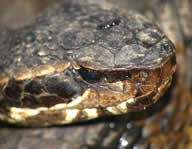 |
|
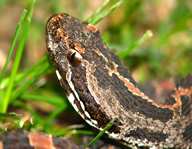 |
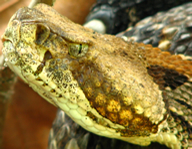 |
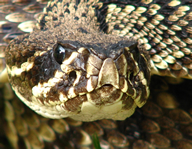 |
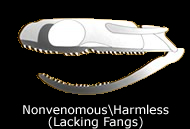


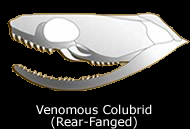
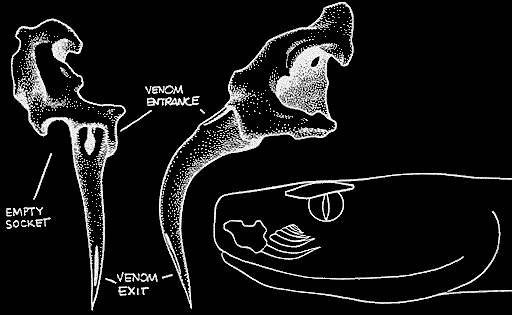
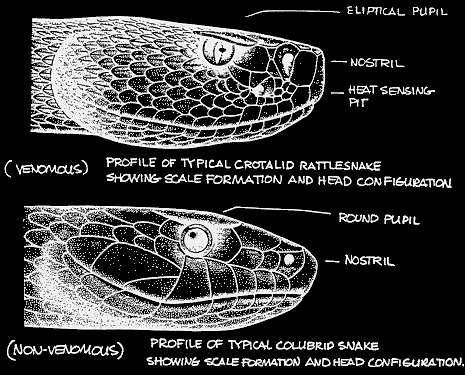
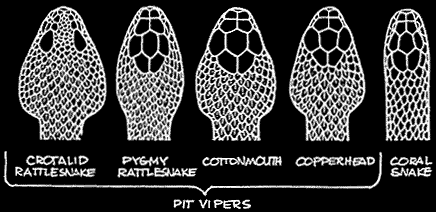
Venoms are highly toxic secretions produced in special oral glands . Because these oral glands are related to the salivary glands of other vertebrates, venom can be considered a modified saliva.
The chemistry of snake venoms is complicated . Venoms are at least 90% protein (by dry weight), and most of the proteins in venoms are enzymes . About 25 different enzymes have been isolated from snake venoms, 12 of which occur in all venoms .
Not
all toxic chemical compounds in snake venoms are enzymes . Polypeptide
toxins, glycoproteins, and low-molecular-weight compounds are also
present in mambas and colubrids . The roles of the other components
of venom are largely unknown .
In
general, snake venom will fall into one of the categories listed below.
-
Hemotoxic venom affects the circulatory ystem (heart and cardiovascular system).
-
Neurotoxic venom affects the nervous system and brain.
| Component | Action | Snake Taxon |
| Anticoagulants | Prevent blood from clotting. | |
| Cardiotoxins | Variable effects that target heart function. Some depolarize cardiac muscles and alter heart contraction, causing heart failure . | associated
mostly with elapids ad vipers |
| Cytolysins | Destroy white blood cells. | viper and pitviper |
| Enzymes | Facilitate chemical reactions. | all venomous species |
| Hemolysins | Destroy red blood cells. | elapids, vipers and pitvipers |
| Hemorrhagins | Destroy capillary walls causing bleeding. (hemorrhages near and distant from the bite) | vipers, pitvipers, and the king cobra |
| Neurotoxins | Block the transmission of nerve impulses to muscles, especially those associated with the diaphragm and breathing | elapids, vipers, tropical rattlesnakes, and some North American Mojave rattlesnakes |
| Proteolysins | Dissolve cells and tissue at the bite site, causing local pain and swelling . | found mostly in viper and pitviper |
| Thromboses | coagulate blood and foster clot formation throughout the circulatory system . | some vipers |
| Compound | Action | Snake Taxon |
| Peptide bradykinin potentiators | Greatly enhance one of the body’s natural responses to injury (dilation and increased permeabilty of blood vessels, stimulation of pain receptors, and contraction of some smooth muscles), thereby enhancing diffusion of venom in the bloodstream, increasing bleeding, and thwarting the ability to flee . | Bothrops, Crotalus |
| Polypeptide toxins | Directly disrupt nerve-impulse transmission, usually causing heart or respiratory failure | Mambas and colubrids :
|
| Proteolytic enzymes | Catalyze the breakdown of structural components of tissues | All venomous species |
| Hyluronidases | Catalyze reactions that break mucopolysaccharide links in connective tissues, thereby enhancing diffusion of venom | Several genera |
| Proteases | Catalyze reactions that disrupt protein peptide bonds in tissues, causing blood-vessel wall damage and hemorrhaging and muscle-fiber deterioration | Vipers, pitvipers |
| Phospholipases | Catalyzes reactions that harm musculature and nerves | Almost all venomous species
|
| Thrombinlike enzymes | Inhibit blood clotting | Vipers, pitvipers, a few elapids (but rare) |
| Nerve growth factor (an enzyme) | Stimulates the growth of nerve cells | Agkistrodon, Crotalus |
| Other enzymes : ribonucleases, deoxyribonucleases, nucleotidases, amino acid oxidases, lactate dehydrogenases, acidic and basic phosphatases | Disrupt normal cellular function, causing death of the affected cells | Vipers and elapids (occurrences vary) |
| Glycoproteins | Suppress normal immune response of tissues through anticomplementary reactions | Some vipers |
| Nucleotides (amino acids) | Not known | Bitis, Dendroaspis, Notechis, Bungarus |
| Biogenic amines | Disrupt normal transmission of nerve impulses and other types of signalling between cells | Agkistrodon, Crotalus, Trimeresurus, Agkistrodon, Crotalus |
| Acectylcholine | Disrupts normal transmission of nerve impulses, causing heart and respiratory failure | Several genera |
| Other Components (Organic and Ignorganic) | Carbohydrates
: Neutral sugars, Amino sugars, Sialic acid . Lipids : Cholesterol, Monoglycerides, Diglycerides, Triglycerides, Phospholipids |
|
| Inorganic ions (which activate and deactivate enzymes) | Macrocomponents
: Calcium, Chlorine, Copper, Iron, Magnesium, Manganese, Nickel,
Phosphate, Potassium, Sodium, Sulfate, Zinc . Microcomponents : Bismuth, Gold, Molybdnum, Palladium, Platinum, Selenium, Silver . Water |
Venom composition can vary among individuals of the same species , and even in the same litter , but variation is greater among geographically different population.
Venom toxicity may also vary over time in the same individual . Generally speaking , the venom of newborn and small juvenile snakes appears to be more potent than that adults of the same species . Also , a bite from a snake that has not fed recently , such as one that has just emerged from hibernation , is more dangerous than that of one that has recently fed , because it has more venom to inject . Venom glands must replace venom lost with each strike-bite , and full replacement takes time .
Snake venom potency is typically determined by conducting an LD50 test. LD stands for "Lethal Dose". LD50 is the amount of a material, given all at once, which causes the death of 50% (one half) of a group of test animals. The LD50 is one way to measure the short-term poisoning potential (acute toxicity) of a material.
The LD50 is usually expressed as the mass of substance administered per unit mass of test subject, such as grams of substance per kilogram of body mass. Stating it this way allows the relative toxicity of different substances to be compared, and normalizes for the variation in the size of the animals exposed (although toxicity does not always scale simply with body mass). Typically, the LD50 of a substance is given in milligrams per kilogram of body weight.
Methods of Testing
Subcutaneous
- Venom is injected under the skin.
Intramuscular
- Venom is injected into a muscle.
Intravenous - Venom
is injected directly into a vein.
Intraperitoneal - Venom
is injected into the abdominal cavity.
Average Venom Yield
- Typical amount of (dry) venom that is obtained through "milking."
The most commonly tested methods are subcutaneous and intravenous injections of mice. Subcutaneous is the most applicable to actual bites.
Note: The LD50 test was created by J.W. Trevan in 1927 but is now being phased out in favor of the Fixed Dose Procedure.
| Species | Intramuscular LD-50s (mg/kg) |
Intraperitoneal LD-50s (mg/kg) |
Intravenous LD-50s (mg/kg) |
Sub-cutaneous LD-50s (mg/kg) |
Average Venom yield |
| Northern Copperhead (Agkistrodon contortrix mokasen) | 4.222 | 2.7 | |||
| Southern Copperhead (Agkistrodon contortrix contortrix) | 20 | 10.9 | 10.9 | 25.6 | 40.0-75.0 |
| Cottonmouth Species (Agkistrodon piscivorus) | 5.1 | 4 | 25.8 | 80.0-170.0 | |
| Eastern Cottonmouth (Agkistrodon piscivorus piscivorus) | |||||
| Florida Cottonmouth (Agkistrodon piscivorus conanti) | |||||
| Western Cottonmouth (Agkistrodon piscivorus leucostoma) | 4.844 | 2.044 | 25.8 | 80.0-170.0 | |
| Carolina Pygmy rattlesnake (Sistrurus miliarius miliarius) | |||||
| Dusky Pygmy rattlesnake (Sistrurus miliarius barbouri) | 6.822 | 12.59 | 24.3 | 12.0-35.0 | |
| Western Pygmy rattlesnake (Sistrurus miliarius streckeri) | 6.822 | 12.59 | 24.3 | 12.0-35.0 | |
| Timber or Canebrake rattlesnake (Crotalus horridus \ atricaudatus) | 2.272 | 2.107 | 3.1 | 75.0-210.0 | |
| Eastern Diamondback rattlesnake (Crotalus adamanteus) | 2.295 | 1.65 | 14.6 | ||
| Eastern Coralsnake (Micrurus fulvius fulvius) | 0.3 | 1.3 |
ALABAMA POISON CENTER
2503 Phoenix Drive
Tuscaloosa, AL 35405Emergency Phone: 1-800-222-1222
If the victim has collapsed or is not breathing, call 911.
Administrative Phone: (205) 345-0609
FAX: (205) 345-7189
Website: www.alapoisoncenter.org
-
Get to the nearest hospital as soon as you can
-
Remain calm and call for help.
-
Restrict movement as much as possible and try to keep the wound below the level of your heart. This will reduce the spread of venom.
-
Take off any jewelry or tight clothing near the bite before swelling starts.
-
Try to remember what the snake looked like: its color, shape and markings. This will help with your treatment.
-
Cover the bite with a clean, dry bandage.
What To Do If Bitten by a Snake in the Elapid Family
This is the standard worldwide accepted first-aid treatment for bites by elapid snakes such as cobras, mambas, coral snakes and many Australian species.
-
Get to the nearest hospital as soon as you can.
-
Allow bite to bleed freely 30 secs.
-
Use Sawyer Extractor (see below) for 15 secs to 1 minute over both fang tracks
-
Cleanse and/or disinfect bite area throughly if possible
-
Apply hard direct pressure over bite using a 4 x 4 gauze pad folded in half x 2
-
oak gauze pad in Betadine(tm) solution if available if not allergic
-
Strap gauze pad tightly in place with adhesive tape
-
Overwrap dressing above and below bite area with ACE bandage
-
Wrap ACE (elastic) bandage as tight as one would for a sprain. Not too tight.
-
Check for pulses above and below elastic wrap; if absent it is too tight
-
Immobilize bitten extremity, use splinting if available
-
If possible, try and keep bitten extremity below heart level or in a gravity dependent position
-
Go to nearest hospital or medical facility as soon as possible
What NOT To Do If Bitten by a Venomous Snake
What to Avoid Reason Why DO NOT physically exert yourself beyond what is necessary to get to a hospital Doing so will increase blood circulation, speeding the spread of the venom beyond the area of the bite. DO NOT take any kind of medication. Medications of any kind, including aspirin and vitamins, may cause unexpected reactions with the venom. Also, many medications, such as aspirin and other pain-killers, thin the blood and speed up the heart. DO NOT eat or drink anything unless advised by medical sources This will facilitate a more accurate diagnosis at the hospital. Of course, common sense should tell you that if you are out in the middle of nowhere fluids will be necessary to avoid dehydration. DO NOT drink alcohol. Alcohol thins the blood, impairs judgment, overworks the kidneys, and stresses the entire body. DO NOT cut the place that has been bitten or try to suck the venom out of the snakebite. Self-surgery (i.e. cutting yourself open) is highly dangerous. An incision that is too deep or misguided could sever nerves (causing permanent paralysis in appendages) or cause massive bleeding. Oral suction or the use of another suction device (as in pellet-shaped snake bite kits) provides inadequate suction to extract venom. In fact, strenuous oral suction can prove physically exhausting and stressful, thus actually worsening the effects of the bite. Evidence suggests that the application of a product called The Extractor does NOT provide any benefits, and may actually cause worse necrosis at the site of the bite. DO NOT apply a constrictive tourniquet, or try to stop the blood flow to or from the snakebite. Constrictions of any kind, even shoes or watches, may stop adequate blood flow. Even the tissues around a snake bite require oxygen! While the proper application of a tourniquet will not stop blood flow, in such a stressful situation it is difficult to apply and monitor a tourniquet. As the area around the wound swells, the tourniquet would require almost constant adjustments. In short, tourniquet are too complicated, too dangerous, and don't work anyway. DO NOT apply hot or cold packs, or ice. Heat may cause blood to flow into the snake bite area, thereby causing the venom to spread more rapidly. On the other hand, cold may reduce the diffusion of the venom too much, thereby causing greater localized tissue damage. DO NOT apply electric shock of any kind. Studies show this does NOT retard or reverse the spread of venom. DO NOT kill or capture the offending snake to bring with you to the hospital. You may put yourself at risk for a second bite in doing so. The antivenin for pit viper bites is the same for all species so identification is rarely necessary. Emergency room personnel will know from the type of bite (punctured versus chewed tissue) whether the attacker was a pit viper or coral snake.
Symptoms of Snakebite Envenomation
Hemotoxic Symptoms
| Double fang marks (but may leave one or three puncture marks) |
| Intense pain |
| Edema - is swelling or puffiness of parts of the body. It is caused by water that gets trapped in the tissues of your body. |
| Weakness |
| Swelling and also swelling in lymph nodes near the bite injury |
| Numbness or tingling around the mouth, tongue, scalp, feet, or the bite area |
| Rapid pulse (changes in heart rate or rhythm) |
| Ecchymoses - usually caused by blunt impact, in which the capillaries are damaged, allowing blood to seep into the surrounding tissue |
| Muscle fasciculation - involuntary contraction of the muscle fibers innervated by a motor unit |
| Paresthesia (oral) - tingling |
| Unusual metallic rubbery, or minty taste in the mouth |
| Vomiting |
| Confusion |
| Bleeding disorders |
Neurotoxic Symptoms
| Double fang marks (but may leave one or three puncture marks) |
| Minimal pain |
| Ptosis
- it is caused by weakness of the muscle responsible for raising
the eyelid, damage to the nerves which control those muscles,
or laxity of the skin of the upper eyelids. |
| Weakness |
| Paresthesia (often numb at bite site) |
| Diplopia - or double vision, is the perception of two images from a single object. The images may be horizontal, vertical, or diagonal. |
| Dysphagia - a medical term defined as difficulty swallowing. |
| Sweating |
| Salivation |
| Diaphoresis - excessive sweating commonly associated with shock and other medical emergency conditions |
| Hyporeflexia - Decreased response of the deep tendon reflexes, usually resulting from injury to the central nervous system or metabolic disease |
| Respiratory depression - depression of respiration (breathing) that results in the reduced availability of oxygen to vital organs |
| Paralysis |
Grading Scale for Severity of Snake Bites
| Degree of envenomation | Presentation | Treatment |
| 0.
None |
Punctures or abrasions; some pain or tenderness at the bite | Local wound care, no antivenin |
| I.
Mild |
Pain, tenderness, edema at the bite; perioral paresthesias may be present. | If antivenin is necessary, it may reqiure about five vials |
| II.
Moderate |
Pain, tenderness, erythema, edema beyond the area adjacent to the bite; often, systemic manifestations and mild coagulopathy | Administration of five to 15 vials of antivenin may be necessary |
| III.
Severe |
Intense pain and swelling of entire extremity, often with severe systemic signs and symptoms;coagulopathy | May require at least 15 to 20 vials of antivenin |
| IV.
Life-threatening |
Marked abnormal signs and symptoms; severe coagulopathy | May require at least 25 vials of antivenin |
Note: There are many, many variables that may affect the behavior of a snake bite, such as:
-
Species (and even geographic location) of snake involved
-
Size of snake
-
Amount of venom injected
-
Size and overall health of bite victim
-
Location and depth of bite
-
Physiology of bite victim
-
Reaction of bite victim: panics, remains calm, delays trip to hospital, etc.
If no symptoms appear within 8 to 12 hours, it is possible that no
venom was injected; this is called a dry
bite. At least 25%, perhaps up to 50%, of bites are
dry.
The severity of symptoms will depend on the type of snake that bit
you, how much poison was injected with the bite, and your personal
health risks.
If poison is injected, about 35% of bites are mild envenomations,
25% are moderate, and 10% to 15% are severe. It is important to remember
that a snake only injects part of its venom with each bite, so it
is still a dangerous threat after the first strike. A young (immature)
snake is more likely to inject all its venom with its first strike
than an older snake. For this reason, a bite from a young snake can
be serious. A dead snake can have a bite reflex up to an hour after
death, so it must be considered dangerous as well. Even if no symptoms
appear within 8 hours, continue to watch for symptoms for up to 24
hours.
Antivenoms,
in general, come in two varieties:
-
Monovalent - Effective against one venom.
-
Polyvalent - Effective against two or more venoms.
| Antivenom | Origin | Company | Country | Species |
| CroFab (Crotalidae Polyvalent Immune Fab) | Ovine | Savage Laboratories | USA | * Crotalus atrox, * Crotalus adamanteus, * Crotalus scutulatus, * Agkistrodon piscivorus, Crotalus horridus, Crotalus viridis helleri, Crotalus molossus molossus, Agkistrodon contortrix, Sistrurus miliarius |
| Antivenin (Crotalidae) Polyvalent | Equine | Wyeth | USA | * Crotalus adamanteus, * Crotalus atrox, * Crotalus durissus terrificus, * Bothrops atrox, Crotalus sp., Sistrurus sp., Agkistrodon contortrix, Agkistrodon piscivorus, Agkistrodon halys, Bothrops sp., Crotalus durissus, Agkistrodon bilineatus, Lachesis mutus |
| Antivenin (Micrurus Fulvius) North American Coral Snake | Equine | Wyeth | USA | * Micrurus fulvius fulvius, * Micrurus fulvius tenere |
| Antivipmyn | Equine | Instituto Bioclon | Mexico | Pitvipers |
| Coralymyn | Equine | Instituto Bioclon | Mexico | Micrurus fulvius |
Species identified by an asterisk (*) indicate venoms used in the actual production of the antivenom.
The production of antivenom involves hyperimmunizing ungulates (sheep or horses) by injecting them over time with increasing quantities of snake venom. Blood is then drawn and fractionated to refine and concentrate the serum globulins. Add a couple of preservatives, such as Phenol and thimerosal, some distiled water, and you have an antivenom. The antibodies produced by the ungulates to combat the toxins in the venom now become the active ingredients in the antivenom.
Antivenom should only be administered by trained professionals for very severe snake bites. Some people have a severe allergy to antivenom (especially those derived from horses) and a skin test is usually standard procedure. Without using caution, the antivenom itself could potentially send someone into life-threatening anaphylaxis! Depending upon the severity of the bite, treatment may require 4 to 18 vials or more. Most antivenoms have no maximum dosage; only it is advised to use the minimum dosage necessary to counteract the effects of the venom.
The cost of antivenom will vary according to the market, but given that
it is expensive to produce and generally in low demand, the price PER
VIAL is likely to be $500-1000! (Remember that several vials are typically
required to treat a bite.)
Due to the cost, relatively short shelf life, and concerns over allergic
reactions, few snake researchers or hobbyists maintain their own antivenom
stockpiles. For native species, antivenom is usually available quite
readily, but the same cannot be said of exotic species. As part of their
snake bite emergency plan, those keeping exotics usually research the
location of the nearest available antivenom. Antivenom banks have become
popular as a way for keepers to divvy up the costs of maintaining antivenoms
for exotic species.
Note:
Click here
for The Miami-Dade Fire Rescue Antivenin
Bank information and antivenom list.
The bite wound will typically consist of 4 curved lines of tiny pinpricks. These correspond with the rows of sharp, pointy teeth. The bite may bleed more than one might expect, due to the sharpness of the teeth and anticoagulant properties of the snake saliva. In some cases, the bite area may mildly itch.
The salivas of some non-venomous colubrids have , in rare instances , caused mild to moderate poisoning in humans . In the United States , people have had reactions to bites of the black-striped snake (Coniophanes imperialis) , ringneck snake (Diadophis punctatus) , western hognose snake (Heterodon nasicus) , cat-eyed snake (Leptodeira septentrionalis) , Mexican vinesnake (Oxybelis aeneus) , western terrestrial gartersnake ( Thamnophis elegans) , common gartersnake (T . sirtalis) , and lyre snake (Trimorphodon biscutatus) . None of these snakes’ venom-delivery systems operates efficiently on humans ; most must chew for the venom to enter the wound . Symptoms of envenomation appear in fewer than 1% of gartersnake bites , though such bites are common among people who handle these snakes . It is possible that the salivas of all colubrids have a toxic component , and that some susceptible than others .
If you are bitten by a non venomous snake you should :
-
Wash the bite area with soap and water
-
Remove any souvenir's (teeth) left behind with tweezers
-
apply antibiotic ointment
-
apply bandage if needed
-
Regularly trim hedges, keep your lawn mowed and remove brush from your yard and any nearby vacant lots. This will reduce the number of places where snakes like to live.
-
Don't allow children to play in vacant, weed-infested lots.
-
Always use tongs when moving firewood, brush or lumber. This will safely expose any snakes that may be hidden underneath.
-
When moving through areas with tall grass and weeds, always poke at the ground ahead of you with a long stick or pole to scare any snakes away.
-
Wear loose, long pants and tall boots when working or walking in areas where snakes are likely to be.
- Do not lift up rocks or wood with hands or feet.
-
Never handle snakes, even dead ones. If you see a snake, slowly back away from it. Most people are bitten trying to get to close.
-
Be aware of snakes if you are swimming or wading in rivers, lakes or other water such as flooding.
-
Learn to identify poisonous snakes and avoid them.
-
Use a good flashlite at night, this includes hiking trails, campsites, and even your front yard! Many snakes become more active at night, especially around dusk and dawn during the warmest parts of summer
- Always sleep on a cot when camping in snake-infested areas.
- In the summer months during times of drought, use extreme caution when in and around areas of water, regardless if it is a trickle of water from the pump of your swimming pool or a large lake. Also pay attention to your outside air conditioning unit during hot summer months. It is usually elevated off the ground , it is shaded and cool, and has an occasional trickle of water under their, making it the perfect place to hang out during the heat of the day.Most everything living thing needs water to survive, including snakes.
How Many Snakes Are Venomous ?
Four families of snakes (Atractaspididae, Colubridae, Elapidae, and Viperidae) include species dangerous to humans, a total of roughly 450 species or about 19% of all snake species .
Venomous Snakes Species of the United States
Note: Venomous species of Alabama are marked in bold Yellow.
(Click on a species to see pictures)
| Rattlesnakes
|
Rattlesnakes |
Rattlesnakes |
Copperheads |
Cottonmouths |
Coral
Snakes |
Sea
Snakes |
Florida
|
Eastern
|
|||||
Osage
|
Western
|
|||||
Southern
|
||||||
New
Mexico Ridge-nosed |
||||||
Western
Pygmy
|
||||||
*Informational Note: There is an ongoing debate on whether or not the Timber Rattlesnake and the Canebrake Rattlesnake are of the same species. For the sake of this table, they will be listed as seperate species.
Landmasses Population (x106) Total number of bites No. of envenomations No. of fatalities 730 25,000 8,000 30 160 20,000 15,000 100 310 45,000 6,500 15 Central and South America 40 300,000 150,000 5,000 Africa 760 1,000,000 500,000 20,000 3,500 4,000,000 2,000,000 100,000 Oceania 20 10,000 3,000 200 5,840 5,400,000 2,682,500 125,345
-
Of the 45,000 snakebites reported annually in the United States, 7,000 to 8,000 are are caused by venomous snakes.
-
15 fatalities result, placing the chance of survival at roughly 499 out of 500.
-
About 3,000 are classed as "illegitimate," meaning these bites occurred while the victim handled or molested the snake.
-
85 percent of natural bites are below the knee.
-
50 percent are dry. Strikes against humans are generally defensive actions. It is estimated that no venom is purposely injected about half the time.
-
Incidence of snakebite is higher in males than in females (Most likely due to alcohol and testostorone) Young adults that are in the 18-28 age group are bitten most commonly.
- The majority of bites in the United States occur in the southwestern part of the country, in part because rattlesnake populations in the eastern states are much lower.[4]
-
The state of North Carolina has the highest frequency of reported snakebites, averaging approximately 19 bites per 100,000 persons. The national average is roughly 4 bites per 100,000 persons.[5]
In the US, Copperheads are responsible for about 25% of venomous snake bites. The American Association of Poison Control Centers (AAPCC) has reported no mortality from Copperhead envenomation since its first annual report in 1983.
Mortality/Morbidity: See cottonmouth
Coral Snake Statistics
In the US, Coral Snakes are responsible for less than 1% of venomous snake bites in the US. Most people bitten by coral snakes are handling them intentionally. Probably less than 20 bites occur per year (though 61 alleged bites were reported to the American Association of Poison Control Centers in 1998). No deaths related to Coral Snake bites have been reported in the US since Coral Snake antivenom became available. Before that time, the estimated case fatality rate was 10%.
Mortality/Morbidity: No deaths related to coral snake bites have been reported in the United States since coral snake antivenom became available. Before that time, the estimated case fatality rate was 10%, and the cause of death was respiratory or cardiovascular failure. Patients who survive the bite may require respiratory support for up to a week and may suffer persistent weakness for weeks to months.
Cottonmouth Statistics
In the US, Cottonmouth are responsible for about 10% of venomous snake bites. The American Association of Poison Control Centers (AAPCC) has reported no mortality from Cottonmouth envenomation since its first annual report in 1983.
Mortality/Morbidity: The American Association of Poison Control Centers (AAPCC) has reported only one death from moccasin envenomation since its first annual report in 1983. Prospective studies of morbidity from moccasin envenomation have not been conducted. However, in two retrospective studies of copperhead victims, patients missed a median of 2 or 6 weeks of work.
Rattlesnake Statistics
Rattlesnakes (includes all species) cause about 75% of all bites by identified venomous snakes in the US. Dry bites, in which there is no envenomation, occur in as many as 50% of strikes. An average of 5.5 deaths per year occur as a result of snake bite in the US, most of these after Rattlesnake bites.
Mortality/Morbidity: Fewer than half a dozen deaths occur per year as a result of snakebite in the United States; most are caused by rattlesnake bites. Estimates of deaths each year from snakebite range from 30,000-110,000 worldwide. Up to 5 times as many individuals experience permanent morbidity.
-
US mortality with administration of antivenin is approximately 0.28%. Without antivenin being administered mortality is approximately 2.6%.
Links
cheap stone islandstone island outletstone island black fridaystone island cheapstone island black friday